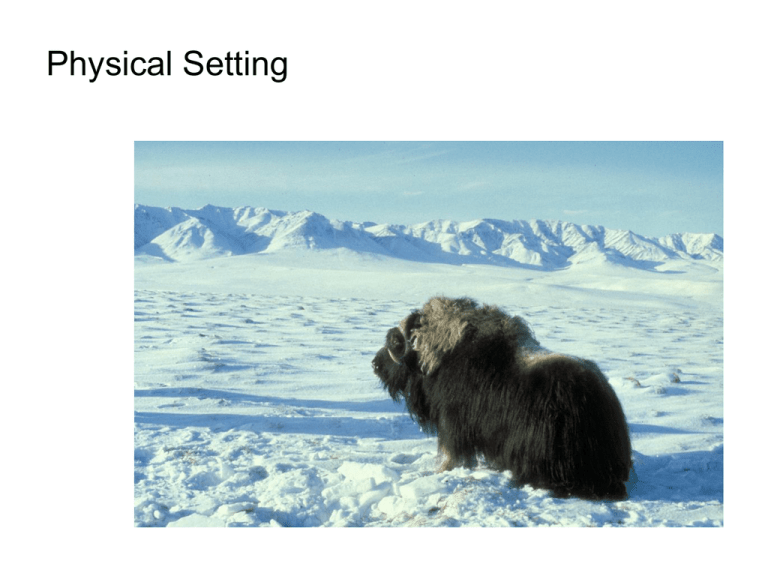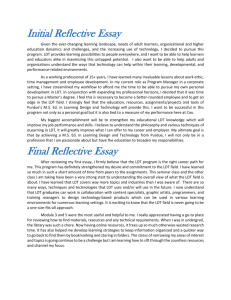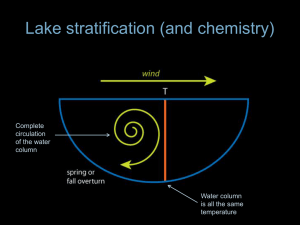The Physical Setting
advertisement

Physical Setting Living organisms are found in virtually every habitat on the planet. However, no single type of organism is found EVERYWHERE. Each has its own, restricted, geographic range. The most significant factor controlling distribution is the physical environment. In terrestrial organisms, distributions may be affected by temperature, precipitation, or soil type. In aquatic organisms, temperature, salinity, light, and pressure are significant. It is well documented that environmental variables vary in a nonrandom manner. It is also well established that more distant sites tend to be more different than closer sites. This relates to distributions in that, as the distance between locations grows, we might expect the environmental conditions to differ. A model for understanding the diversity of geographic patterns. A key factor in determining climate zones and, therefore, the distribution of habitat types is the angle of incident radiation. This is a function of latitude. As the earth moves around the sun, the angle of incidence varies at different latitudes. Because this tilted angle of rotation is maintained as the earth revolves around the sun, the amount of sunlight received by the Northern and Southern Hemispheres varies seasonally. Further complicating matters is the fact that the earth’s axis is tilted at an angle of 23.5 to the plane of the ecliptic. Summer solstice Autumnal equinox Winter solstice Vernal equinox June 21 Sun over Tropic of Cancer September 23 Sun over Equator December 21 Sun over Tropic of Capricorn March Sun over Equator The unequal heating of the earth’s surface sets up a series of “cells” of rising and falling air as one moves from the equator to the poles. Solar-driven, latitude and atmospheric circulation Superimposed on this pattern of air movement is the Coriolis Effect, which causes moving objects in the Northern Hemisphere to have an apparent curve to the right, while causing a curve to the left in the Southern Hemisphere. Expanding gases undergo adiabatic cooling. So, rising airs cools. As it does, the water vapor it contains condenses. Rain shadows may result when air moving over a mountain cools and loses its moisture. The leeward side of the mountain experiences dry winds. Dry air cools with elevation faster than humid air. Therefore the air on the leeward side of a mountain range is warmer and drier than the same elevation on the windward side. A precipitation map of Oregon illustrates the rain shadow effect of the Coast Range and the Cascades. Small-Scale Spatial and Temporal Variation Great variation can be created on a local scale. Mountains can have a particularly strong effect. Examine the effect of elevation on climate. A high elevation site in Arizona is more similar to one 1500 km away in Oregon than a low elevation site 15 miles away in Arizona. The spruce forests high on the slopes of the Great Smoky Mountains National Park are similar to those of boreal forests of Canada. Puerto Rico has a high, mountainous “backbone”. Lowlands on the northern and eastern sides of the island are lush and tropical. As the northeast trade winds move across high backbone of the island, they lose much of the moisture they contain. As a result, the southwestern corner of the island is extremely dry, with flora similar to that of western Mexico. The cold Humboldt current, flowing north along the Pacific coast of South America, along with the rain shadow cast by the Andes Mountains, leads to a dramatic difference over a rather short distance. As much as 10 m of rain falls annually on the tropical rain forests on the eastern slope of the Andes. The Atacama Desert to the west may go years without rain. There are also year-to-year and longer term variations in climate. The entire global system of moving fluids fluctuates on a 5-7 year cycle. These fluctuations seem to be linked to events in the tropical Pacific Ocean known as the El Niňo Southern Oscillation. The trigger is uncertain, but ENSO leads to a change in the pattern of circulation in the tropical ocean. The warm equatorial countercurrent may become stronger and push water up the coasts of North and South America. Westerly winds may carry moisture inland causing heavy precipitation in the winter when the air temperature is colder than the offshore waters. ENSO is also associated with reduced coastal upwellling, which may impact the entire marine food chain and greatly impact fisheries. Ocean currents are driven by prevailing winds. Continents block the flow, and create a northern and southern gyre in the Atlantic and Pacific. The global pattern of winds leads to global patterns of oceanic circulation. The earth’s major climatic regions. Note the pattern with respect to latitude. Other factors influencing climatic patterns are continents, oceans, mountain ranges. Soils The type of vegetation fouind in a region dependings primarily on three factors: 1. Climate. 2. History of disturbance. 3. Soils. Soil formation is a chemical and biological process resulting from the weathering of rock and the accumulation of organic material from dead and decaying organisms. Four characteristic processes produce the primary soil types: 1. Podzolization – characteristic of temperate deciduous and coniferous forests. 2. Lateralization – characteristic of tropical forests. 3. Calcification – typical of arid grasslands and shrublands. 4. Gleization – typical of waterlogged tundra. Climate is the primary determinant of soil type. Two primary climatological factors that figure in soil type are temperature and aridity. Lake Zonation Stratification is a characteristic feature of lakes. Vertical temperature stratification of Lake Mendota, WI from summer through winter showing the loss of stratification with cooling. Summer Stratification In summer, solar radiation heats the surface water. It becomes lighter, and floats on the colder, denser water beneath. The warm upper water is not easily mixed with the water beneath it, creating a barrier. The warm surface water is called the epilimnion, and grows progressively deeper during the summer. Beneath the thermal barrier is a middle mass of water known as the metalimnion. This mass is characterized by a steep and rapid decline in temperature known as the thermocline. Beneath the metalimnion is the cold, dense hypolimnion. The warming of the surface water during the summer months leads to summer stratification. As the temperature drops in the fall, the depth of the epilimnion decreases. Fall Overturn Eventually, the temperature of the water is uniform from top to bottom, the waters of the lake circulate, and oxygen and nutrients are recharged throughout the lake. This seasonal mixing is called overturn. Stirred by the wind, it may last until ice forms. Winter Stratification As the surface water cools below 4C., it becomes lighter and remains on the surface. If the climate is cold enough, the surface water freezes. If not, it remains close to 0C. A slight inverse stratification may develop in which the water becomes warmed up to 4C. with depth. During the summer, oxygen may also become stratified in lakes and ponds. The amount of oxygen is usually greatest at the surface, due primarily to interchange with the atmosphere. Typically, the amount of oxygen decreases with depth because of decomposition in bottom sediments. Tides The action of centrifugal force on the earth and the gravitational pull of the moon to produce tides. On the side of the earth facing the moon, the pull of the moon’s gravity is greater than centrifugal force and the net tidal force pulls water toward the moon. On the side opposite the moon, centrifugal force outweights gravitational pull, and the net force draws water away from the moon. While the Gulf of Mexico has diurnal tides, most locations show semidiurnal fluctuations. Tide calendar for the northern Gulf of California. June - Horn Island, Mississippi Sound 06/09/2008 Mon 12:30AM LDT 0.1 L 01:57PM LDT 1.2 H 06/10/2008 Tue 12:19AM LDT 11:07AM LDT 1.0 H 10:30PM LDT 0.6 L 0.4 L 06/11/2008 Wed 08:10AM LDT 1.0 H 2008 Horn Island Pass Tides 06:00PM LDT 0.4 L Microclimatic variation can result in dramatically different conditions over very small spatial scales. We can see similar microclimatic differences in aquatic habitats. Alamuchee Creek – Sumter County, AL Longear sunfish Rock darter











